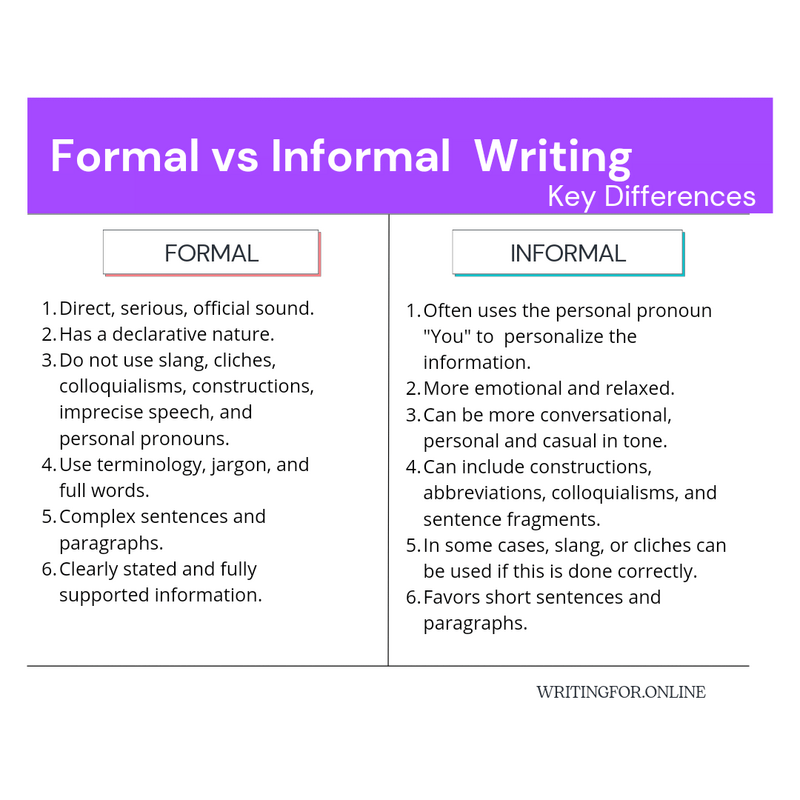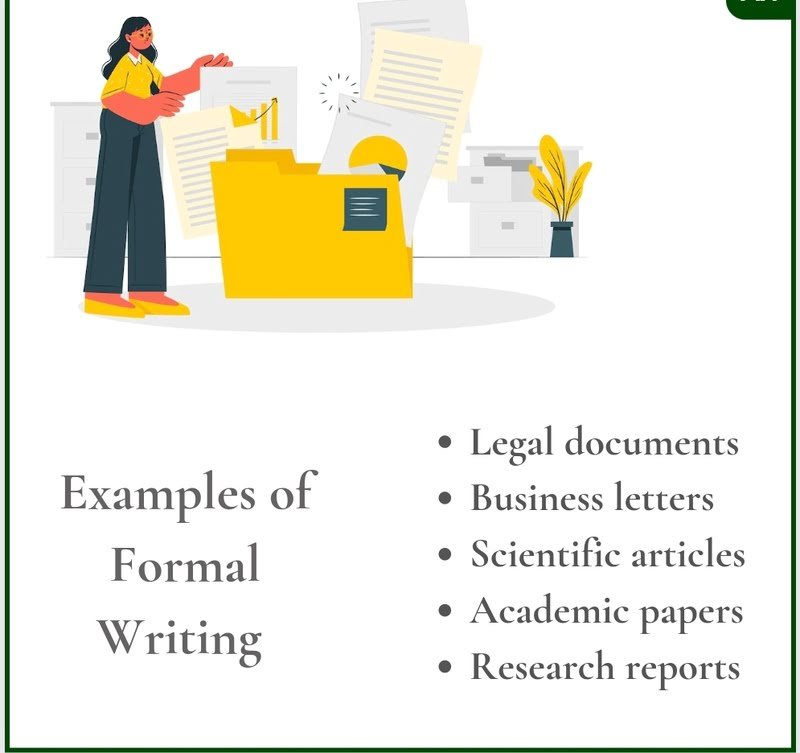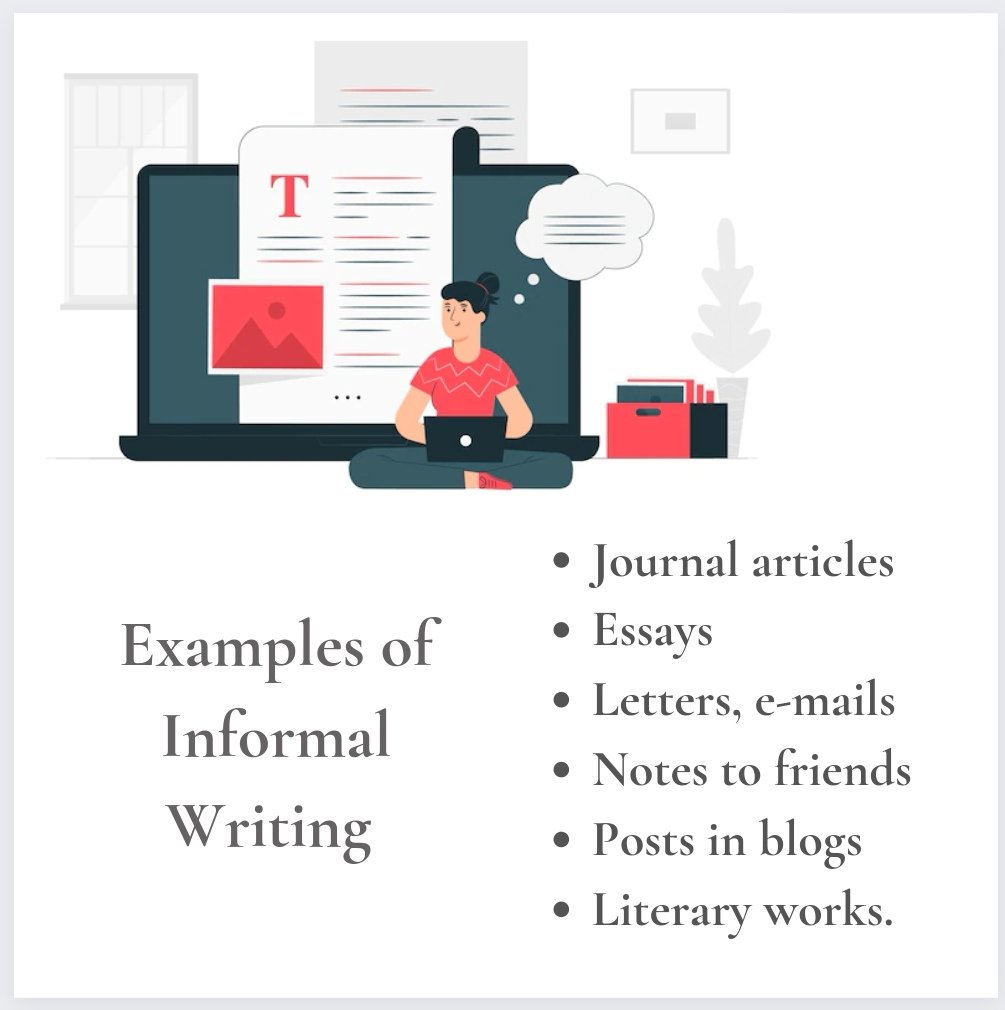In this article, you will learn what is formal and informal writing styles (as well as slang), examples, and key differences between formal and informal styles.
Table of Contents
Formal and Informal Writing Style: Why Does the Right Choice Matter?
To write any text, be it a book, story, scientific paper, essay, review, or blog post, in addition to a good vocabulary, it is necessary to choose the right writing style.
Because even a rich vocabulary will not be enough if you do not know how to use words correctly depending on the context and in what style to write.
For example, it’s completely wrong to use slang in academic writing, but it’s okay to use it in your blog. It would be a mistake to write a commercial proposal in an overly formal style, but a scientific article is quite appropriate.
This article will help you avoid mistakes and write your writing piece in the right style.
What Is Style in Writing?
Style in writing (or writing style) is the choice of words to express thoughts and ideas.
But this choice is often not as simple as it seems. Let’s see why.
What Are Formal, Informal Writing Styles, and Slang?
The writing style can be formal or informal (it is also known as colloquial). Besides, in some writing pieces, you can find slang.
For example:
- “It was a pleasure meeting you” – formal writing style.
- “See you later” – informal style.
- “See ya” – slang.
Formal Writing: Definition
Formal writing style implies the use of exclusively professional, restrained, complex vocabulary, no words from colloquial speech, and, especially, slang.
This style is appropriate for writing legal documents, business letters, scientific reports, and academic and research papers.
Read also post “What Is Business Writing Style: Characteristics, Types, and Examples”.
Informal Writing
Informal writing is a more personal, emotional, and conversational style that often reflects how we communicate with each other in real life.
The most striking example of using this style is literary works.
Types of informal writing in literature are:
- Informal essay.
- Drama and fiction.
- Poetry. This is the most popular type of informal writing.
Informal writing is usually used by writers when addressing a familiar audience, discussing some entertaining topic, or crafting the narrative.
What Is Slang?
Slang is a vocabulary of new words, abbreviations, or modified words that are used in conversation or writing by various subcultures, groups of people, or in a particular context (for example, youth slang, computer or football slang).
Key Differences between Formal and Informal Writing Styles and Characteristics

Characteristics of formal writing style:
- Usually, the author refers to himself in the third person (“the researcher”, for example).
- Many sentences may be constructed in the passive voice.
- More factual.
- Direct, serious, official sound.
- Has a declarative nature.
- Do not use slang, cliches, colloquialisms, constructions, imprecise speech, and personal pronouns.
- Use terminology, jargon, and full words.
- Complex sentences and paragraphs.
- Clearly stated and fully supported information.
You need to remember that a chosen writing style must fit the intended audience.
Characteristics of informal writing style:
- More active voice sentences.
- Personal pronouns such as “I” and “We” are used as subjects of sentences.
- Often uses the personal pronoun “You” to engage the reader in the topic and personalize the information.
- More emotional and relaxed.
- Can be more conversational, personal, and casual in tone.
- Informal writing can include constructions, abbreviations, colloquialisms, and sentence fragments.
- Does not necessarily follow conventions.
- In some cases, slang, or cliches can be used if this is done correctly.
- Favors short sentences and paragraphs.
Examples of Formal Writing Style
As you already know, the formal style of writing is used when crafting legal documents, scientific and academic papers, and research reports.
Read post “What Is Scientific Writing: Characteristics, Types, and Examples”.

Example 1
Example of formal writing: research report
Abstract
The Evidence on Busing. Research Report
Armor, David J.
Public Interest, n28 p90-126 Sum 1972
The development of school integration programs throughout the country has made possible a test of the hypothesis that school integration enhances black achievement, aspirations, self-esteem, race relations, and opportunities for higher education. The programs reviewed here have two important characteristics that may limit ability to their being generalized: they are examples of induced integration, and all use varying amounts of busing to accomplish integration. Five reports on integration programs in Northern cities throughout the country are cited: (1) Project METCO, Boston, Massachusetts; (2) White Plains, New York; (3) Ann Arbor, Michigan; (4) Riverside, California; and, (5) Project Concern, Hartford and New Haven, Connecticut. To test the hypothesis, findings are grouped under five major headings–the effects of busing and integration on: (1) academic achievement; (2) aspirations; (3) self-concept; (4) race relations; and (5) educational opportunities. Program support is also examined. In each case, bused students are compared with the control groups to assess those changes that might be uniquely associated with the effects of induced integration. The implications of these findings for policy are then examined. Since the data do not support the hypothesis on most counts, the burden must fall upon those who support a given school integration program to demonstrate that it has the intended effects–with no unintended, negative side-effects.
Example 2
Example of formal writing: resolution
Resolution adopted by the General Assembly on 8 September 2022
Reaffirming the request to the Secretary-General to inform Member States and to engage in broad and inclusive consultations with them, all parts of the United Nations system and other relevant partners on his proposals in the report as they relate to the Summit of the Future, including through providing concise, action-oriented recommendations for the consideration of Member States as an input into the intergovernmental preparations for the Summit, Taking note of the summaries of the informal thematic consultations held under the auspices of the President of the General Assembly in connection with the report of the Secretary-General entitled “Our Common Agenda”,
Affirming the importance of the modalities of the Summit of the Future being developed by Member States,
1. Decides that the Summit of the Future has an important role to play in reaffirming the Charter of the United Nations, reinvigorating multilateralism, boosting implementation of existing commitments, agreeing on concrete solutions to challenges and restoring trust among Member States;
2. Also decides that the theme of the Summit shall be “Summit of the Future: multilateral solutions for a better tomorrow”;
3. Further decides that the Summit will be held on 22 and 23 September 2024, in New York, preceded by a preparatory ministerial meeting to be held on 18 September 2023;
4. Decides that the Summit will adopt a concise, action-oriented outcome document entitled “A Pact for the Future”, agreed in advance by consensus through intergovernmental negotiations;
Examples of Informal Writing
Informal writing has a broad audience and the rules for the writing of any text will vary with different readers.

Examples of informal writing are journal articles, essays, letters, e-mails, notes to friends, posts in personal blogs, or literary works.
Example 1
Example of informal writing: post in personal blog.
Abstract from a blog post
Social listening metrics & KPIs: What (and how) to track
by Anna Bredava
Aesthetically pleasing socials are one thing. But aesthetically pleasing, pointedly written posts — that’s a whole other ball game. And anyway, how do you know when your posts are hitting a home run or whether they’re missing the base completely? The secret is in the results.
Of course, your business should always be result-oriented, and this is especially true in difficult economic times or in times of unpredictability, when it’s crucial to avoiding wasting any resources you have (be it time, money, or people) and, instead, focus on something much more valuable.
So, then how do you ensure your business strategies are not being implemented in vain? How can you be certain that the steps you take lead you to your business goals? By evaluating these steps, of course! That’s right—with key performance indicators (aka KPIs).
Example 2
Example of informal writing in literature.
Abstract
A novella “And Every Morning the Way Home Gets Longer and Longer” by Fredrik Backman
There’s a hospital room at the end of a life where someone, right in the middle of the floor, has pitched a green tent. A person wakes up inside it, breathless and afraid, not knowing where he is. A young man sitting next to him whispers:
“Don’t be scared.”
Isn’t that the best of all life’s ages, an old man thinks as he looks at his grandchild. When a boy is just big enough to know how the world works but still young enough to refuse to accept it. Noah’s feet don’t touch the ground when his legs dangle over the edge of the bench, but his head reaches all the way to space, because he hasn’t been alive long enough to allow anyone to keep his thoughts on Earth. His grandpa is next to him and is incredibly old, of course, so old now that people have given up and no longer nag him to start acting like an adult. So old that it’s too late to grow up. It’s not so bad either, that age.
Conclusion
Of course, our native language, just like foreign languages, is constantly changing: new words appear, and old unclaimed ones disappear.
The world is changing and this is reflected in our language, communication, and speech. Therefore, the choice of the right writing style and the right words must comply with the existing rules and norms at a given time.
Used sources of information:
- Writing for Publication in Nursing, Fourth Edition. By Marilyn H. Oermann, Judith C. Hays.
- Essay Writing: Teaching the Basics from the Ground Up. By Jock Mackenzie.
- ATI TEAS Strategies, Practice & Review with 2 Practice Tests: Online + Book. By Kaplan (COR), Kaplan Nursing.
- Editing for the Digital Age. By Thom Lieb.
- The Keys to Academic Success. By Arthur L. Ellis.
- Images: freepik.com.
P. S.: If this article was interesting to you, please, share the link! Thank you!